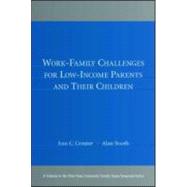
Note: Supplemental materials are not guaranteed with Rental or Used book purchases.
Purchase Benefits
What is included with this book?
| Preface | ix | ||||
| PART I How Has the Availability, Content, and Stability of the Jobs Available for the Working Poor Changed in Recent Decades? | |||||
|
3 | (32) | |||
|
|||||
|
35 | (10) | |||
|
|||||
|
45 | (10) | |||
|
|||||
|
55 | (28) | |||
|
|||||
| PART II What Features of Work Timing Matter for Families? | |||||
|
83 | (24) | |||
|
|||||
|
107 | (10) | |||
|
|||||
|
117 | (10) | |||
|
|||||
|
127 | (12) | |||
|
|||||
| PART III How are the Childcare Needs of Low-Income Families Being Met? | |||||
|
139 | (26) | |||
|
|||||
|
165 | (14) | |||
|
|||||
|
179 | (12) | |||
|
|||||
|
191 | (12) | |||
|
|||||
| PART IV How are the Challenges of Managing Work and Family Experienced by Low-Income Men and Women? | |||||
|
203 | (40) | |||
|
|||||
|
243 | (8) | |||
|
|||||
|
251 | (14) | |||
|
|||||
|
265 | (8) | |||
|
|||||
|
273 | (14) | |||
|
|||||
| Author Index | 287 | (6) | |||
| Subject Index | 293 |
The New copy of this book will include any supplemental materials advertised. Please check the title of the book to determine if it should include any access cards, study guides, lab manuals, CDs, etc.
The Used, Rental and eBook copies of this book are not guaranteed to include any supplemental materials. Typically, only the book itself is included. This is true even if the title states it includes any access cards, study guides, lab manuals, CDs, etc.